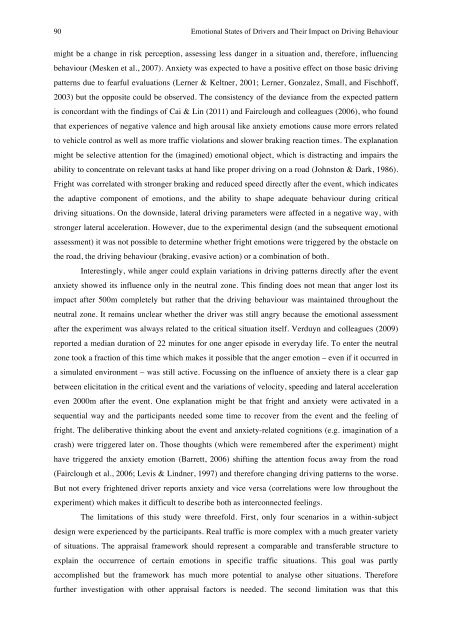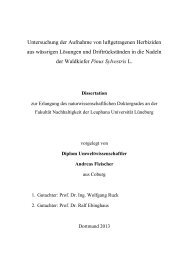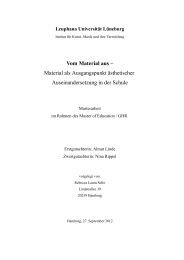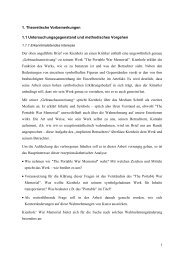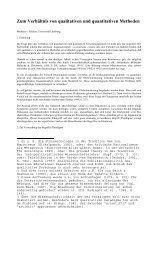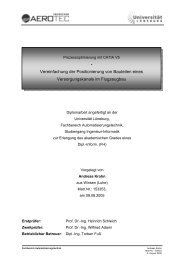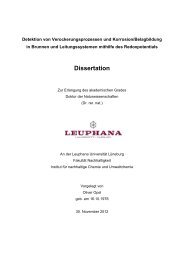Determinants of Emotional Experiences in Traffic Situations ... - OPUS
Determinants of Emotional Experiences in Traffic Situations ... - OPUS
Determinants of Emotional Experiences in Traffic Situations ... - OPUS
You also want an ePaper? Increase the reach of your titles
YUMPU automatically turns print PDFs into web optimized ePapers that Google loves.
90 <strong>Emotional</strong> States <strong>of</strong> Drivers and Their Impact on Driv<strong>in</strong>g Behaviour!<br />
might be a change <strong>in</strong> risk perception, assess<strong>in</strong>g less danger <strong>in</strong> a situation and, therefore, <strong>in</strong>fluenc<strong>in</strong>g<br />
behaviour (Mesken et al., 2007). Anxiety was expected to have a positive effect on those basic driv<strong>in</strong>g<br />
patterns due to fearful evaluations (Lerner & Keltner, 2001; Lerner, Gonzalez, Small, and Fischh<strong>of</strong>f,<br />
2003) but the opposite could be observed. The consistency <strong>of</strong> the deviance from the expected pattern<br />
is concordant with the f<strong>in</strong>d<strong>in</strong>gs <strong>of</strong> Cai & L<strong>in</strong> (2011) and Fairclough and colleagues (2006), who found<br />
that experiences <strong>of</strong> negative valence and high arousal like anxiety emotions cause more errors related<br />
to vehicle control as well as more traffic violations and slower brak<strong>in</strong>g reaction times. The explanation<br />
might be selective attention for the (imag<strong>in</strong>ed) emotional object, which is distract<strong>in</strong>g and impairs the<br />
ability to concentrate on relevant tasks at hand like proper driv<strong>in</strong>g on a road (Johnston & Dark, 1986).<br />
Fright was correlated with stronger brak<strong>in</strong>g and reduced speed directly after the event, which <strong>in</strong>dicates<br />
the adaptive component <strong>of</strong> emotions, and the ability to shape adequate behaviour dur<strong>in</strong>g critical<br />
driv<strong>in</strong>g situations. On the downside, lateral driv<strong>in</strong>g parameters were affected <strong>in</strong> a negative way, with<br />
stronger lateral acceleration. However, due to the experimental design (and the subsequent emotional<br />
assessment) it was not possible to determ<strong>in</strong>e whether fright emotions were triggered by the obstacle on<br />
the road, the driv<strong>in</strong>g behaviour (brak<strong>in</strong>g, evasive action) or a comb<strong>in</strong>ation <strong>of</strong> both.<br />
Interest<strong>in</strong>gly, while anger could expla<strong>in</strong> variations <strong>in</strong> driv<strong>in</strong>g patterns directly after the event<br />
anxiety showed its <strong>in</strong>fluence only <strong>in</strong> the neutral zone. This f<strong>in</strong>d<strong>in</strong>g does not mean that anger lost its<br />
impact after 500m completely but rather that the driv<strong>in</strong>g behaviour was ma<strong>in</strong>ta<strong>in</strong>ed throughout the<br />
neutral zone. It rema<strong>in</strong>s unclear whether the driver was still angry because the emotional assessment<br />
after the experiment was always related to the critical situation itself. Verduyn and colleagues (2009)<br />
reported a median duration <strong>of</strong> 22 m<strong>in</strong>utes for one anger episode <strong>in</strong> everyday life. To enter the neutral<br />
zone took a fraction <strong>of</strong> this time which makes it possible that the anger emotion – even if it occurred <strong>in</strong><br />
a simulated environment – was still active. Focuss<strong>in</strong>g on the <strong>in</strong>fluence <strong>of</strong> anxiety there is a clear gap<br />
between elicitation <strong>in</strong> the critical event and the variations <strong>of</strong> velocity, speed<strong>in</strong>g and lateral acceleration<br />
even 2000m after the event. One explanation might be that fright and anxiety were activated <strong>in</strong> a<br />
sequential way and the participants needed some time to recover from the event and the feel<strong>in</strong>g <strong>of</strong><br />
fright. The deliberative th<strong>in</strong>k<strong>in</strong>g about the event and anxiety-related cognitions (e.g. imag<strong>in</strong>ation <strong>of</strong> a<br />
crash) were triggered later on. Those thoughts (which were remembered after the experiment) might<br />
have triggered the anxiety emotion (Barrett, 2006) shift<strong>in</strong>g the attention focus away from the road<br />
(Fairclough et al., 2006; Levis & L<strong>in</strong>dner, 1997) and therefore chang<strong>in</strong>g driv<strong>in</strong>g patterns to the worse.<br />
But not every frightened driver reports anxiety and vice versa (correlations were low throughout the<br />
experiment) which makes it difficult to describe both as <strong>in</strong>terconnected feel<strong>in</strong>gs.<br />
The limitations <strong>of</strong> this study were threefold. First, only four scenarios <strong>in</strong> a with<strong>in</strong>-subject<br />
design were experienced by the participants. Real traffic is more complex with a much greater variety<br />
<strong>of</strong> situations. The appraisal framework should represent a comparable and transferable structure to<br />
expla<strong>in</strong> the occurrence <strong>of</strong> certa<strong>in</strong> emotions <strong>in</strong> specific traffic situations. This goal was partly<br />
accomplished but the framework has much more potential to analyse other situations. Therefore<br />
further <strong>in</strong>vestigation with other appraisal factors is needed. The second limitation was that this


